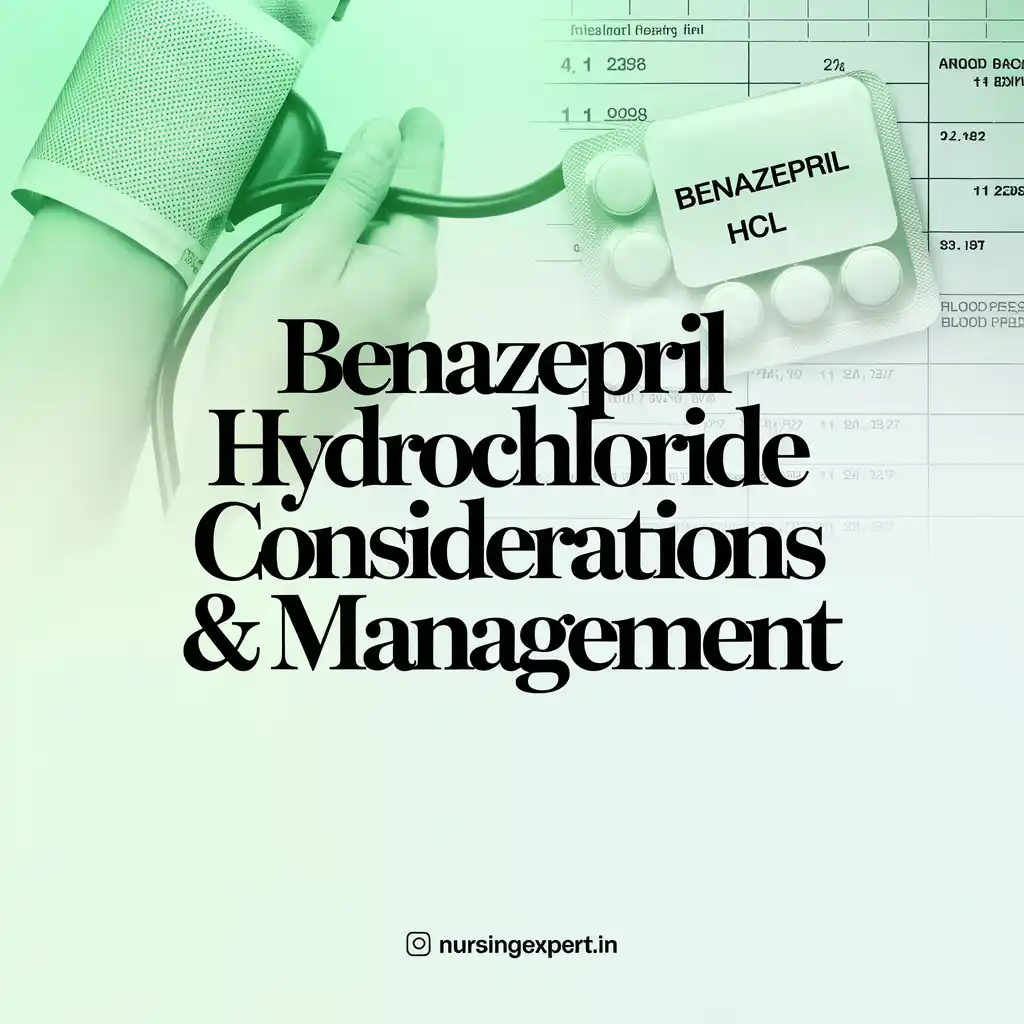Benazepril hydrochloride is an angiotensin-converting enzyme (ACE) inhibitor commonly prescribed for hypertension and heart failure. It works by relaxing blood vessels, lowering blood pressure, and reducing the heart’s workload. Nurses play a critical role in ensuring its safe and effective use through careful monitoring, patient education, and management of side effects. Below is a detailed guide to nursing considerations and management strategies for benazepril.
Thank you for reading this post, don't forget to subscribe!
Overview of Benazepril
- Class: ACE inhibitor
- Action: Inhibits conversion of angiotensin I to angiotensin II, leading to vasodilation and decreased blood volume.
- Indications: Hypertension, heart failure, and sometimes diabetic nephropathy.
- Brand Name: Lotensin


Key Nursing Considerations
1. Monitoring
- Vital Signs: Check blood pressure and heart rate regularly, especially after the first dose, to detect hypotension.
- Renal Function: Monitor serum creatinine and blood urea nitrogen (BUN) periodically.
- Electrolytes: Assess potassium levels to watch for hyperkalemia.
2. Patient Education
- Symptoms to Report: Teach patients to notify healthcare providers if they experience dizziness, lightheadedness, or swelling (potential angioedema).
- Adherence: Emphasize taking the medication as prescribed and not stopping it suddenly.
- Positioning: Advise rising slowly from sitting or lying to avoid orthostatic hypotension.
3. Drug Interactions
- Diuretics: May increase hypotension risk; monitor blood pressure closely.
- Potassium Supplements: Can lead to hyperkalemia; check potassium levels.
- NSAIDs: May reduce benazepril’s effectiveness; advise limited use.
4. Side Effects
- Common: Dry cough, headache, fatigue.
- Serious: Angioedema (swelling of face, lips, or throat), kidney dysfunction.
- Management: Discontinue immediately if angioedema occurs; report severe side effects to the provider.
5. Contraindications
- History of angioedema from ACE inhibitors.
- Bilateral renal artery stenosis.
- Pregnancy (Category D – risk of fetal harm).
6. Dosage
- Starting Dose: Typically 5-10 mg daily, adjusted based on response.
- Renal Impairment: Lower doses (e.g., 5 mg) for patients with reduced kidney function.
- Titration: Increase gradually under medical supervision.
7. Laboratory Monitoring
- Renal Tests: Regular checks of kidney function, especially in at-risk patients.
- Potassium: Watch for levels >5.5 mEq/L, indicating hyperkalemia.
8. Lifestyle Support
- Diet: Recommend a low-sodium diet to enhance blood pressure control.
- Hydration: Ensure adequate fluid intake unless contraindicated.
9. Emergency Preparedness
- Be ready for rare but severe reactions like anaphylaxis or profound hypotension.
- Have emergency equipment (e.g., epinephrine) accessible.
Administration Tips
- Timing: Can be taken with or without food; consistency is key.
- First-Dose Effect: Observe for hypotension, especially in patients on diuretics or with low fluid volume.
- Missed Dose: Take as soon as remembered unless close to the next dose; avoid doubling up.
Special Considerations
- Elderly: Start with lower doses (e.g., 5 mg) due to increased sensitivity.
- Renal Impairment: Adjust dosing based on creatinine clearance (CrCl); avoid if CrCl <30 mL/min without specialist input.
- Pregnancy: Contraindicated; counsel women of childbearing age on risks.
Conclusion
Benazepril hydrochloride is an effective treatment for hypertension and heart failure when managed carefully. Nurses ensure its success by monitoring vital signs and labs, educating patients, and addressing side effects promptly. Through these efforts, patient safety and therapeutic outcomes are optimized.
Disclaimer: Consult a healthcare provider for individualized medical advice.


